Assignment On Reflective Scenario
VerifiedAdded on 2022/09/18
|7
|1199
|22
Assignment
AI Summary
Contribute Materials
Your contribution can guide someone’s learning journey. Share your
documents today.
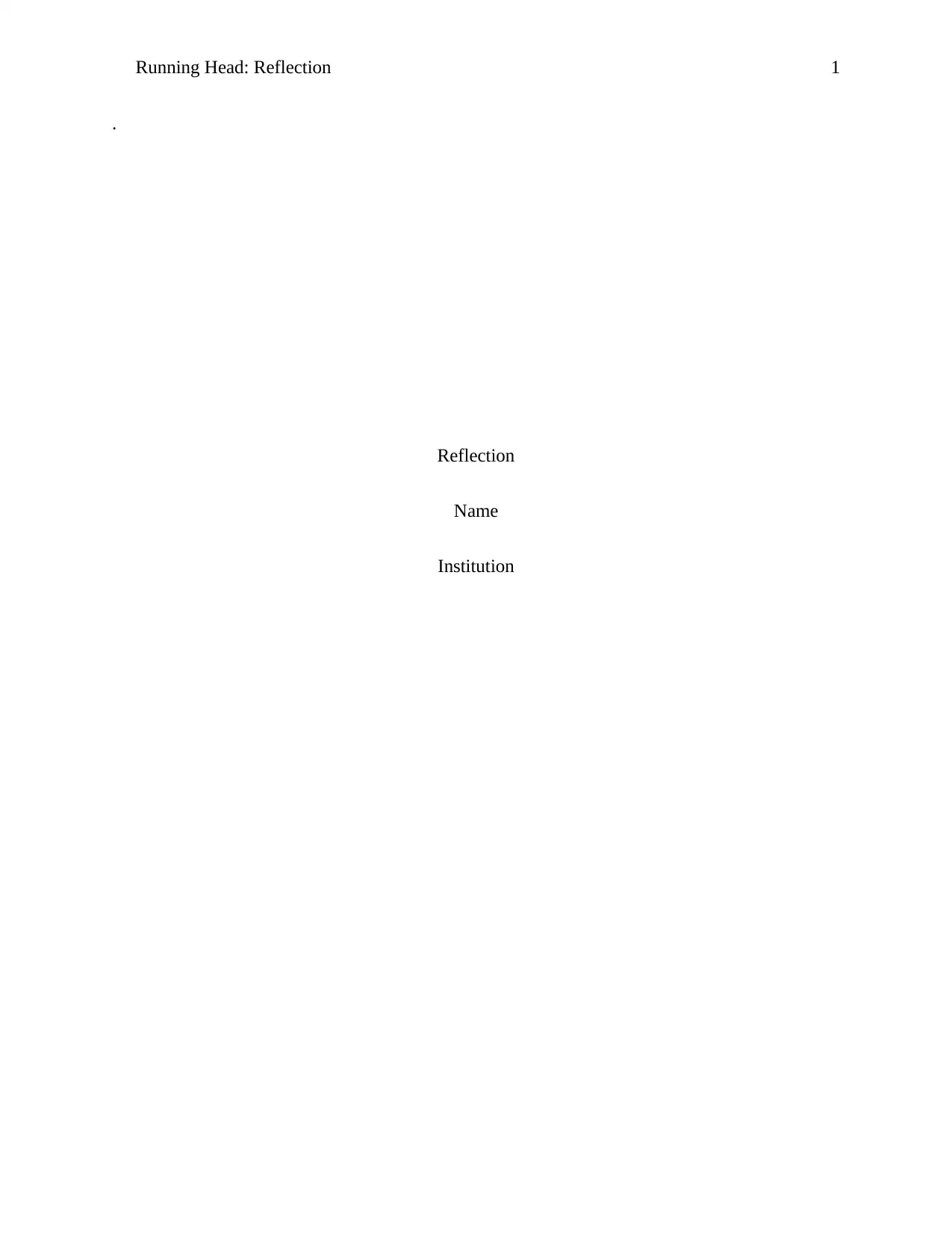
Running Head: Reflection 1
.
Reflection
Name
Institution
.
Reflection
Name
Institution
Secure Best Marks with AI Grader
Need help grading? Try our AI Grader for instant feedback on your assignments.
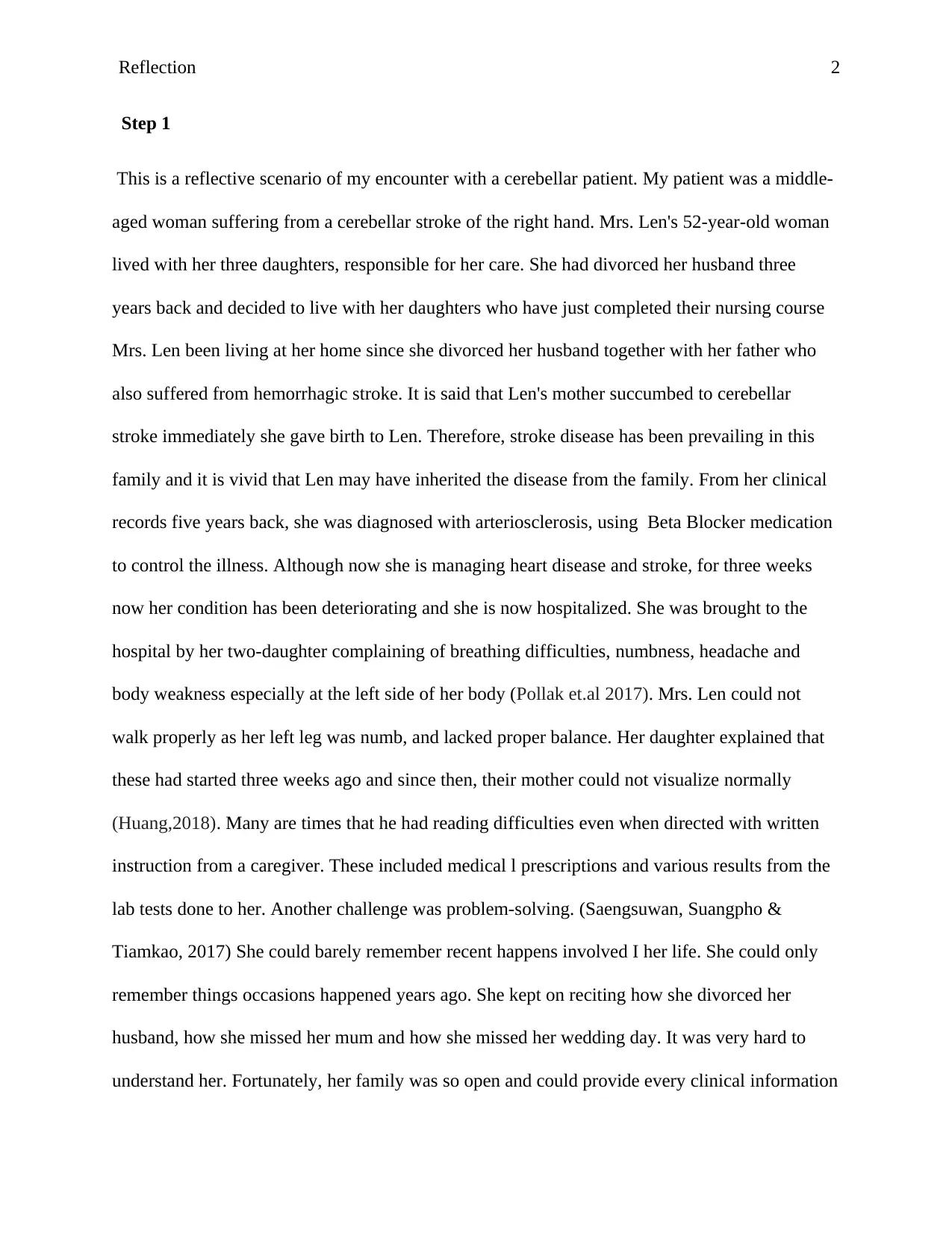
Reflection 2
Step 1
This is a reflective scenario of my encounter with a cerebellar patient. My patient was a middle-
aged woman suffering from a cerebellar stroke of the right hand. Mrs. Len's 52-year-old woman
lived with her three daughters, responsible for her care. She had divorced her husband three
years back and decided to live with her daughters who have just completed their nursing course
Mrs. Len been living at her home since she divorced her husband together with her father who
also suffered from hemorrhagic stroke. It is said that Len's mother succumbed to cerebellar
stroke immediately she gave birth to Len. Therefore, stroke disease has been prevailing in this
family and it is vivid that Len may have inherited the disease from the family. From her clinical
records five years back, she was diagnosed with arteriosclerosis, using Beta Blocker medication
to control the illness. Although now she is managing heart disease and stroke, for three weeks
now her condition has been deteriorating and she is now hospitalized. She was brought to the
hospital by her two-daughter complaining of breathing difficulties, numbness, headache and
body weakness especially at the left side of her body (Pollak et.al 2017). Mrs. Len could not
walk properly as her left leg was numb, and lacked proper balance. Her daughter explained that
these had started three weeks ago and since then, their mother could not visualize normally
(Huang,2018). Many are times that he had reading difficulties even when directed with written
instruction from a caregiver. These included medical l prescriptions and various results from the
lab tests done to her. Another challenge was problem-solving. (Saengsuwan, Suangpho &
Tiamkao, 2017) She could barely remember recent happens involved I her life. She could only
remember things occasions happened years ago. She kept on reciting how she divorced her
husband, how she missed her mum and how she missed her wedding day. It was very hard to
understand her. Fortunately, her family was so open and could provide every clinical information
Step 1
This is a reflective scenario of my encounter with a cerebellar patient. My patient was a middle-
aged woman suffering from a cerebellar stroke of the right hand. Mrs. Len's 52-year-old woman
lived with her three daughters, responsible for her care. She had divorced her husband three
years back and decided to live with her daughters who have just completed their nursing course
Mrs. Len been living at her home since she divorced her husband together with her father who
also suffered from hemorrhagic stroke. It is said that Len's mother succumbed to cerebellar
stroke immediately she gave birth to Len. Therefore, stroke disease has been prevailing in this
family and it is vivid that Len may have inherited the disease from the family. From her clinical
records five years back, she was diagnosed with arteriosclerosis, using Beta Blocker medication
to control the illness. Although now she is managing heart disease and stroke, for three weeks
now her condition has been deteriorating and she is now hospitalized. She was brought to the
hospital by her two-daughter complaining of breathing difficulties, numbness, headache and
body weakness especially at the left side of her body (Pollak et.al 2017). Mrs. Len could not
walk properly as her left leg was numb, and lacked proper balance. Her daughter explained that
these had started three weeks ago and since then, their mother could not visualize normally
(Huang,2018). Many are times that he had reading difficulties even when directed with written
instruction from a caregiver. These included medical l prescriptions and various results from the
lab tests done to her. Another challenge was problem-solving. (Saengsuwan, Suangpho &
Tiamkao, 2017) She could barely remember recent happens involved I her life. She could only
remember things occasions happened years ago. She kept on reciting how she divorced her
husband, how she missed her mum and how she missed her wedding day. It was very hard to
understand her. Fortunately, her family was so open and could provide every clinical information
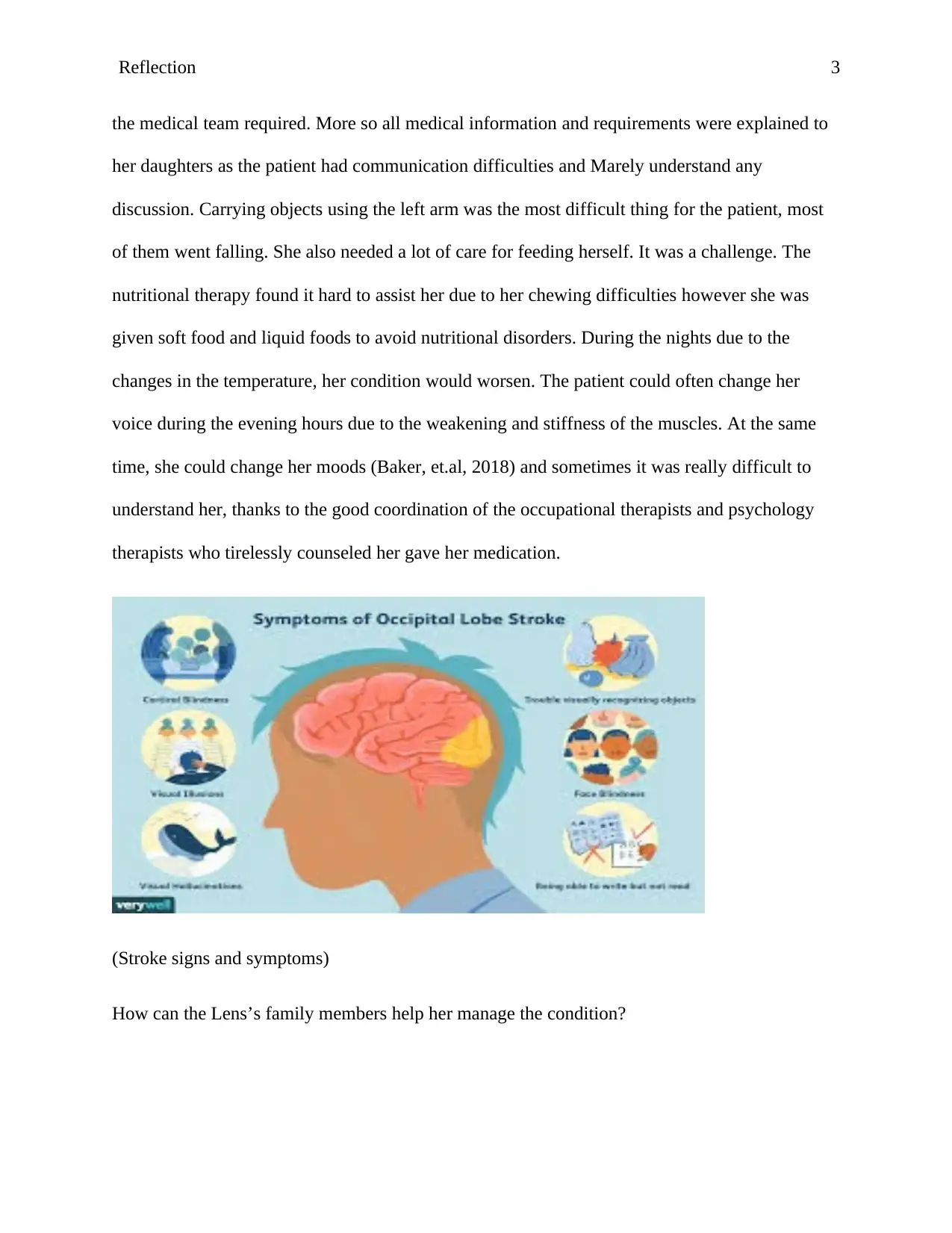
Reflection 3
the medical team required. More so all medical information and requirements were explained to
her daughters as the patient had communication difficulties and Marely understand any
discussion. Carrying objects using the left arm was the most difficult thing for the patient, most
of them went falling. She also needed a lot of care for feeding herself. It was a challenge. The
nutritional therapy found it hard to assist her due to her chewing difficulties however she was
given soft food and liquid foods to avoid nutritional disorders. During the nights due to the
changes in the temperature, her condition would worsen. The patient could often change her
voice during the evening hours due to the weakening and stiffness of the muscles. At the same
time, she could change her moods (Baker, et.al, 2018) and sometimes it was really difficult to
understand her, thanks to the good coordination of the occupational therapists and psychology
therapists who tirelessly counseled her gave her medication.
(Stroke signs and symptoms)
How can the Lens’s family members help her manage the condition?
the medical team required. More so all medical information and requirements were explained to
her daughters as the patient had communication difficulties and Marely understand any
discussion. Carrying objects using the left arm was the most difficult thing for the patient, most
of them went falling. She also needed a lot of care for feeding herself. It was a challenge. The
nutritional therapy found it hard to assist her due to her chewing difficulties however she was
given soft food and liquid foods to avoid nutritional disorders. During the nights due to the
changes in the temperature, her condition would worsen. The patient could often change her
voice during the evening hours due to the weakening and stiffness of the muscles. At the same
time, she could change her moods (Baker, et.al, 2018) and sometimes it was really difficult to
understand her, thanks to the good coordination of the occupational therapists and psychology
therapists who tirelessly counseled her gave her medication.
(Stroke signs and symptoms)
How can the Lens’s family members help her manage the condition?
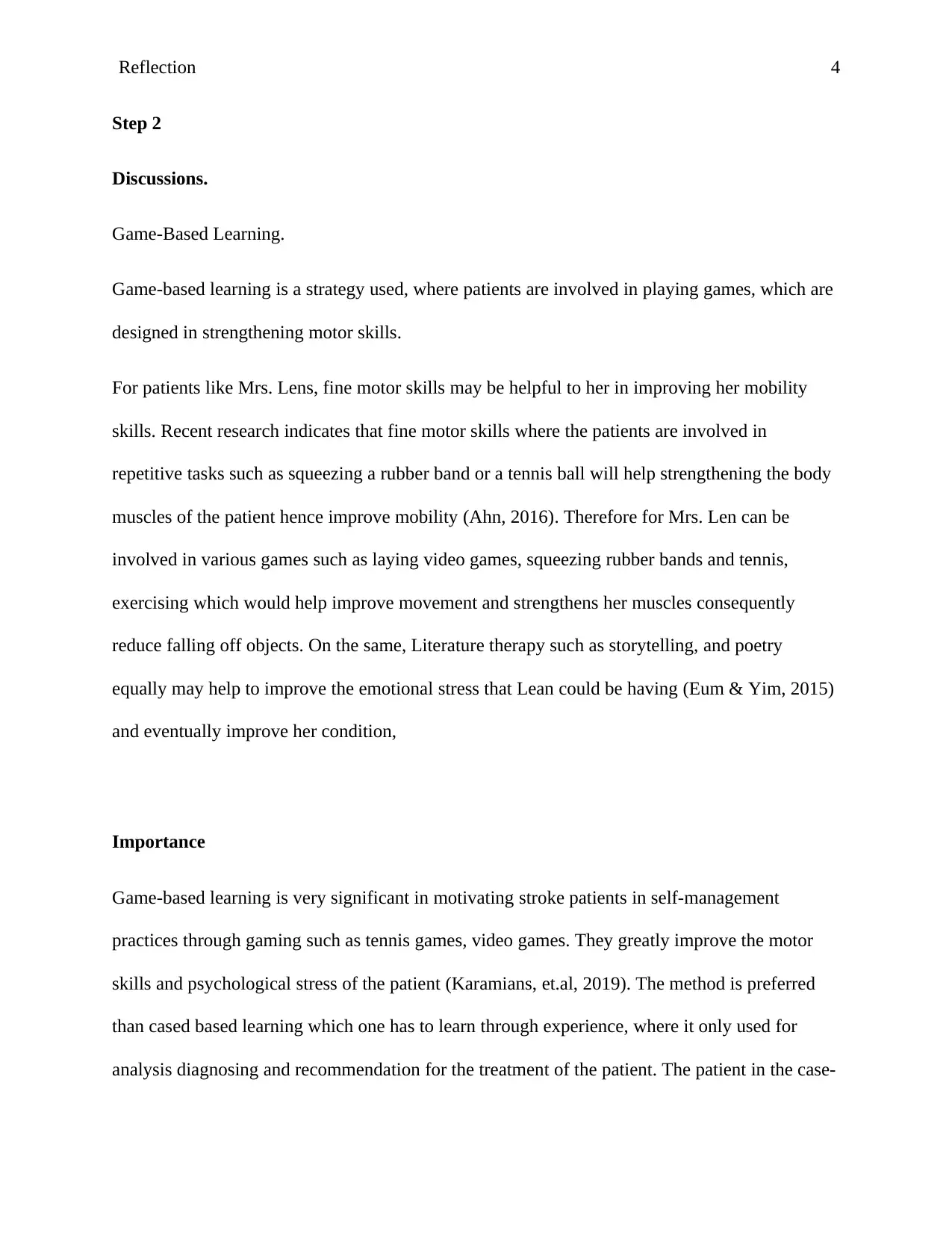
Reflection 4
Step 2
Discussions.
Game-Based Learning.
Game-based learning is a strategy used, where patients are involved in playing games, which are
designed in strengthening motor skills.
For patients like Mrs. Lens, fine motor skills may be helpful to her in improving her mobility
skills. Recent research indicates that fine motor skills where the patients are involved in
repetitive tasks such as squeezing a rubber band or a tennis ball will help strengthening the body
muscles of the patient hence improve mobility (Ahn, 2016). Therefore for Mrs. Len can be
involved in various games such as laying video games, squeezing rubber bands and tennis,
exercising which would help improve movement and strengthens her muscles consequently
reduce falling off objects. On the same, Literature therapy such as storytelling, and poetry
equally may help to improve the emotional stress that Lean could be having (Eum & Yim, 2015)
and eventually improve her condition,
Importance
Game-based learning is very significant in motivating stroke patients in self-management
practices through gaming such as tennis games, video games. They greatly improve the motor
skills and psychological stress of the patient (Karamians, et.al, 2019). The method is preferred
than cased based learning which one has to learn through experience, where it only used for
analysis diagnosing and recommendation for the treatment of the patient. The patient in the case-
Step 2
Discussions.
Game-Based Learning.
Game-based learning is a strategy used, where patients are involved in playing games, which are
designed in strengthening motor skills.
For patients like Mrs. Lens, fine motor skills may be helpful to her in improving her mobility
skills. Recent research indicates that fine motor skills where the patients are involved in
repetitive tasks such as squeezing a rubber band or a tennis ball will help strengthening the body
muscles of the patient hence improve mobility (Ahn, 2016). Therefore for Mrs. Len can be
involved in various games such as laying video games, squeezing rubber bands and tennis,
exercising which would help improve movement and strengthens her muscles consequently
reduce falling off objects. On the same, Literature therapy such as storytelling, and poetry
equally may help to improve the emotional stress that Lean could be having (Eum & Yim, 2015)
and eventually improve her condition,
Importance
Game-based learning is very significant in motivating stroke patients in self-management
practices through gaming such as tennis games, video games. They greatly improve the motor
skills and psychological stress of the patient (Karamians, et.al, 2019). The method is preferred
than cased based learning which one has to learn through experience, where it only used for
analysis diagnosing and recommendation for the treatment of the patient. The patient in the case-
Secure Best Marks with AI Grader
Need help grading? Try our AI Grader for instant feedback on your assignments.

Reflection 5
based method may not be engaged in therapeutic measures for controlling her conditions rather
she is given only scenarios or cases which are similar to her conditions and through it, she is
advised on how to manage her condition.
based method may not be engaged in therapeutic measures for controlling her conditions rather
she is given only scenarios or cases which are similar to her conditions and through it, she is
advised on how to manage her condition.
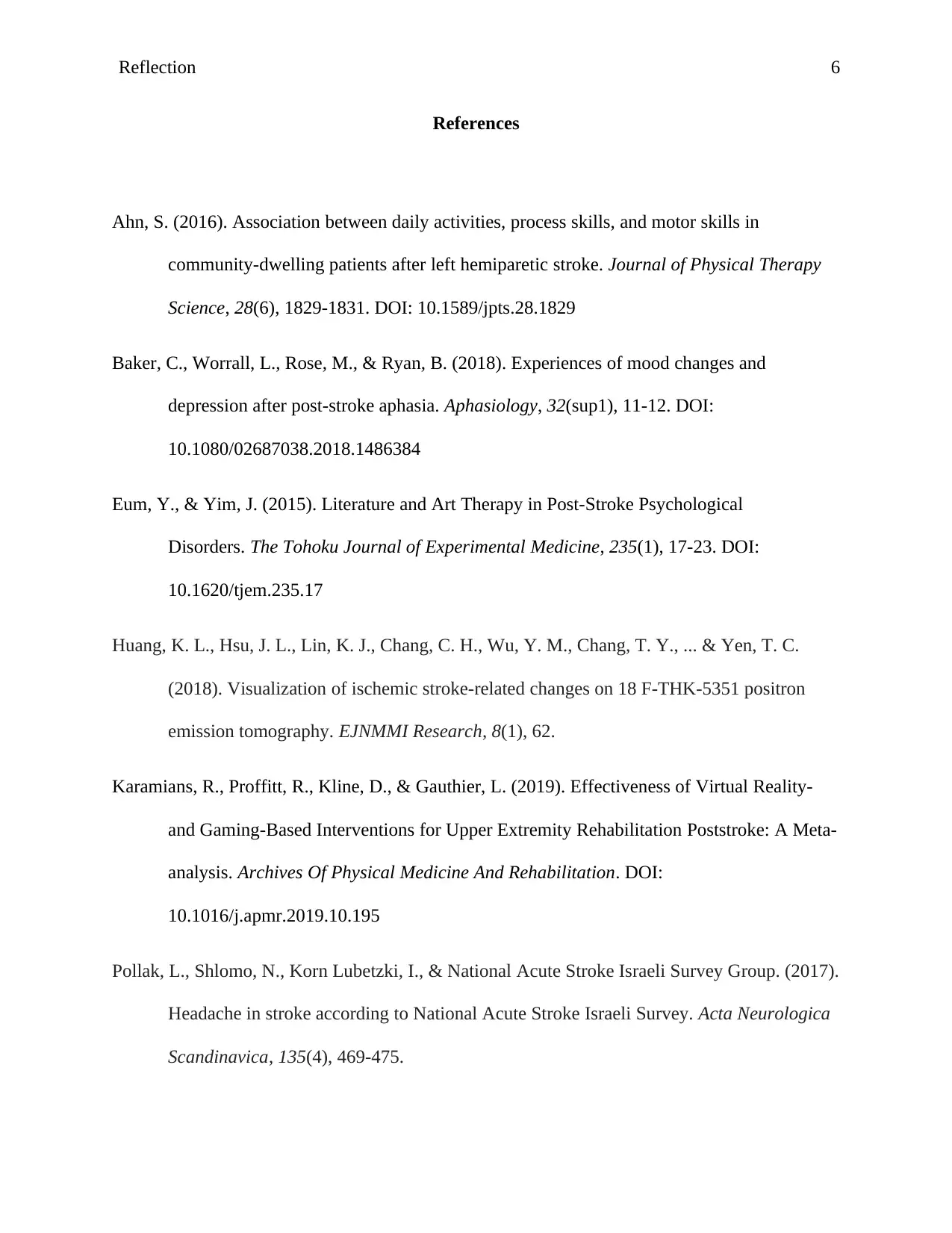
Reflection 6
References
Ahn, S. (2016). Association between daily activities, process skills, and motor skills in
community-dwelling patients after left hemiparetic stroke. Journal of Physical Therapy
Science, 28(6), 1829-1831. DOI: 10.1589/jpts.28.1829
Baker, C., Worrall, L., Rose, M., & Ryan, B. (2018). Experiences of mood changes and
depression after post-stroke aphasia. Aphasiology, 32(sup1), 11-12. DOI:
10.1080/02687038.2018.1486384
Eum, Y., & Yim, J. (2015). Literature and Art Therapy in Post-Stroke Psychological
Disorders. The Tohoku Journal of Experimental Medicine, 235(1), 17-23. DOI:
10.1620/tjem.235.17
Huang, K. L., Hsu, J. L., Lin, K. J., Chang, C. H., Wu, Y. M., Chang, T. Y., ... & Yen, T. C.
(2018). Visualization of ischemic stroke-related changes on 18 F-THK-5351 positron
emission tomography. EJNMMI Research, 8(1), 62.
Karamians, R., Proffitt, R., Kline, D., & Gauthier, L. (2019). Effectiveness of Virtual Reality-
and Gaming-Based Interventions for Upper Extremity Rehabilitation Poststroke: A Meta-
analysis. Archives Of Physical Medicine And Rehabilitation. DOI:
10.1016/j.apmr.2019.10.195
Pollak, L., Shlomo, N., Korn Lubetzki, I., & National Acute Stroke Israeli Survey Group. (2017).
Headache in stroke according to National Acute Stroke Israeli Survey. Acta Neurologica
Scandinavica, 135(4), 469-475.
References
Ahn, S. (2016). Association between daily activities, process skills, and motor skills in
community-dwelling patients after left hemiparetic stroke. Journal of Physical Therapy
Science, 28(6), 1829-1831. DOI: 10.1589/jpts.28.1829
Baker, C., Worrall, L., Rose, M., & Ryan, B. (2018). Experiences of mood changes and
depression after post-stroke aphasia. Aphasiology, 32(sup1), 11-12. DOI:
10.1080/02687038.2018.1486384
Eum, Y., & Yim, J. (2015). Literature and Art Therapy in Post-Stroke Psychological
Disorders. The Tohoku Journal of Experimental Medicine, 235(1), 17-23. DOI:
10.1620/tjem.235.17
Huang, K. L., Hsu, J. L., Lin, K. J., Chang, C. H., Wu, Y. M., Chang, T. Y., ... & Yen, T. C.
(2018). Visualization of ischemic stroke-related changes on 18 F-THK-5351 positron
emission tomography. EJNMMI Research, 8(1), 62.
Karamians, R., Proffitt, R., Kline, D., & Gauthier, L. (2019). Effectiveness of Virtual Reality-
and Gaming-Based Interventions for Upper Extremity Rehabilitation Poststroke: A Meta-
analysis. Archives Of Physical Medicine And Rehabilitation. DOI:
10.1016/j.apmr.2019.10.195
Pollak, L., Shlomo, N., Korn Lubetzki, I., & National Acute Stroke Israeli Survey Group. (2017).
Headache in stroke according to National Acute Stroke Israeli Survey. Acta Neurologica
Scandinavica, 135(4), 469-475.
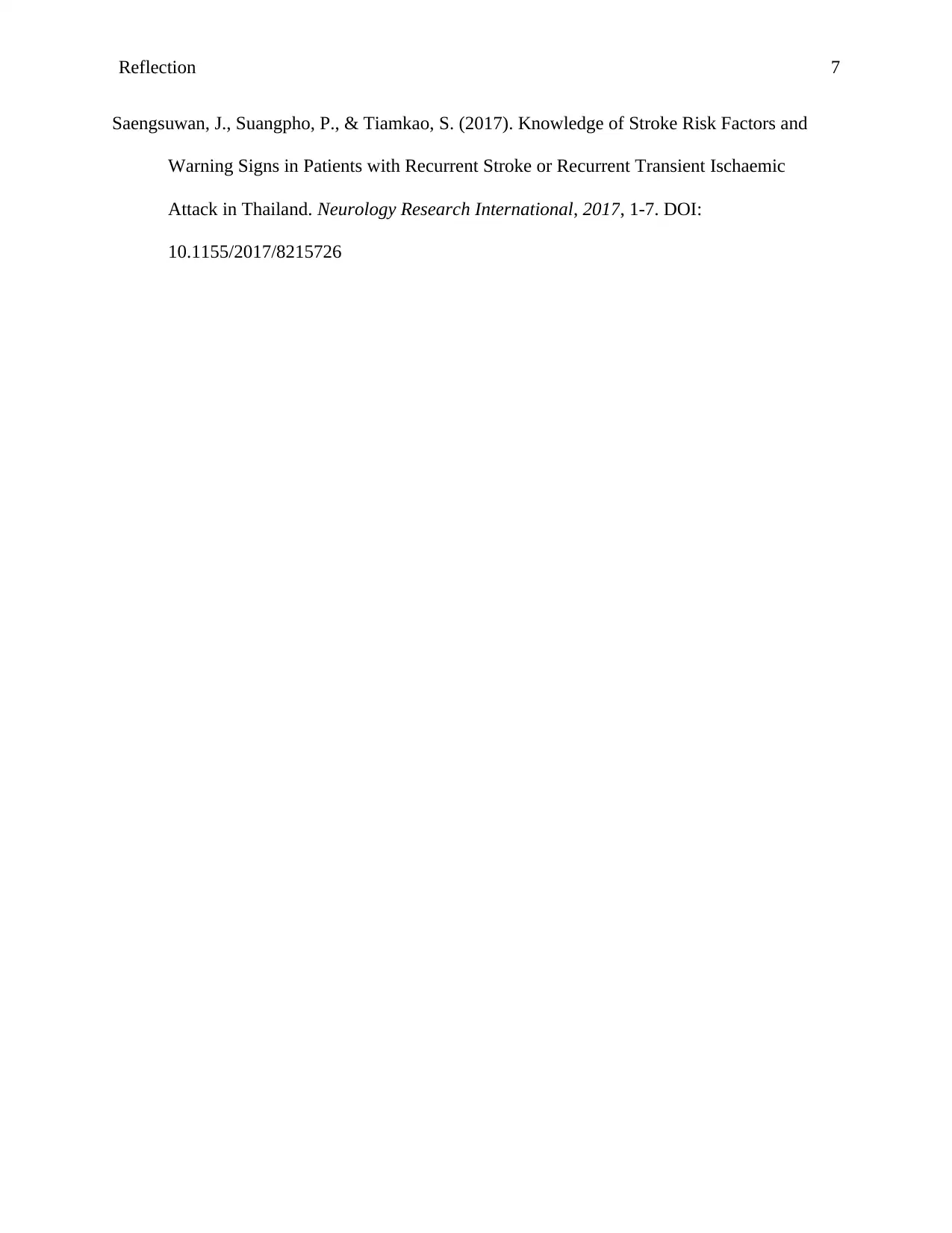
Reflection 7
Saengsuwan, J., Suangpho, P., & Tiamkao, S. (2017). Knowledge of Stroke Risk Factors and
Warning Signs in Patients with Recurrent Stroke or Recurrent Transient Ischaemic
Attack in Thailand. Neurology Research International, 2017, 1-7. DOI:
10.1155/2017/8215726
Saengsuwan, J., Suangpho, P., & Tiamkao, S. (2017). Knowledge of Stroke Risk Factors and
Warning Signs in Patients with Recurrent Stroke or Recurrent Transient Ischaemic
Attack in Thailand. Neurology Research International, 2017, 1-7. DOI:
10.1155/2017/8215726
1 out of 7
Related Documents
Your All-in-One AI-Powered Toolkit for Academic Success.
+13062052269
info@desklib.com
Available 24*7 on WhatsApp / Email
![[object Object]](/_next/static/media/star-bottom.7253800d.svg)
Unlock your academic potential
© 2024 | Zucol Services PVT LTD | All rights reserved.





